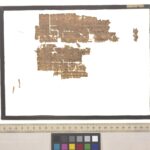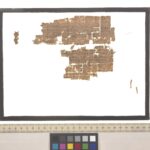| Artefact ID | 559 |
| TM ID | TM 61986 |
| Findspot (DEChriM ID) | - () | Class | Textual |
| Material | Papyrus |
| Writing medium | Codex |
| Text content | Literary |
| Language | Greek |
| Description | P.Grenf. I 5, Aland AT145 Fragments of a folio containing Ezechiel 5.12-17 and 6.1-3 from an early, 'revised' Septuagint employing the diacritical marks of Origen. The papyrus fragment measures 14 x 10.7 cm, and preserves the upper part of a folio (upper margin is preserved) of a squared codex (estimated to measure approx. 14 x 14-15 cm). The content appears to be a text from the Septuagint (Ezechiel 5.12-17 and 6.1-3) with added diacritical signa that mark the differences (additions and omissions) from the Hebrew Bible, similar to hexaplaric abridgements in the Codices Colberto-Sarravianus (4/5 c.) and Marchalianus (6th c.). The fragment appears to agree more closely with the latter (MS Q; Codex Marchalianus, which also contains Ezechiel), although there is a stark difference in the use of the sigla: P.Grenf. I 5 adheres more faithfully to Origenes original use of the sigla, while MS Q has extended the use of asterisks to also indicate phrasal inversion; see ref. ed. The proximity in the usus places the fragment close to (if not overlapping with) the original Biblical revision of Origenes. The fragment is possibly the oldest authority for the Septuagint (see ed. pr.), and is slightly longer than MS Ω (the Göttingen Septuagint) due to the asterisk-additions in the style of Origenes; see ref. ed. The text appears to agree with the Hebrew bible in several instances, both concerning additions (such as are lacking from the LXX) and in the choice of phrasing, and the ref. ed. suggests that the passages were taken from Greek translations of the original Hebrew of said Bible. The hand can be described as sloping uncial in the Severe style. A homoioteleuton has caused an omission in l. 15 on the verso, and the text otherwise contains several nomina sacra and diacritical asterisks. The latter was used in the style of Origenes, in which the asterisks and obeloi were employed as specific critical signa that aided a comparison of the Greek text with the Hebrew bible. As such, the fragment is an early witness to a 'revised' edition of the Septuagint, following closest the critical usus of Origines; see ref. ed. The date (late 3rd/ early 4th in the ref. ed.) would align the text with a period in which Pamphilus and Eusebius were actively preparing revised editions of the Septuagint based on Origenes's synoptic Hexapla. |
| Selection criteria | Literary genre (Biblical), Nomina sacra |
| Date from | 275 |
| Date to | 350 |
| Dating criteria | Palaeography. The sloping uncials of the fragment is placed in 250-350 by the ed. pr., and the ref. ed. gives the comparandum of P.Chester Beatty VI 11 (Ecclesiasticus 36-37 and 46-47 from first half of the 4th c.), which points to a date in the late 3rd/early 4th c. The fragment has since been dated to the first half of the 4th c. by P. Orsini on TM. |
| Absolute/relative date | Relative date |
| Archaeological context | Provenance is Arsinoites (Fayum). |
| Accession number | Oxford, Bodleian Library MS. Gr. bib. d. 4 (P). |
ARTEFACT IDENTIFIERS
Reference edition:
∙ Schironi, Francesca. 2015. "P.Grenf. 1.5, Origen, and the Scriptorium of Caesarea". Bulletin of the American Society of Papyrologists 52. 181-223.
Editio princeps:
∙ Grenfell, Bernard P. 1896. P. Grenf. vol. I: An Alexandrian Erotic Fragment and other Greek Papyri chiefly Ptolemaic. Oxford. 9-11, papyrus no. 5.
Additional bibliography:
∙ Aland, Kurt. 1976. Repertorium der griechischen christlichen Papyri: 1. Biblische Papyri: Altes Testament, Neues Testament, Varia, Apokryphen. Altes Testament 145.
∙ Falconer Madan and H. H. E. Craster, eds. 1922. A summary catalogue of western manuscripts in the Bodleian Library at Oxford which have not hitherto been catalogued in the Quarto series: Vol. II, part I. Oxford. Record no. 31708.
∙ Rahlfs, Alfred and Detlef Fraenkel. 2004 (1914). Verzeichnis der griechischen Handschriften des Alten Testaments. Göttingen. 279, descr. no. 922.
∙ Turner, Eric G. 1977. The Typology of the Early Codex. University of Pennsylvania Press. 183.
∙ van Haelst, Joseph. 1976. Catalogue des papyrus littéraires juifs et chrétiens. Paris. Description no. 314.


 Json data
Json data





